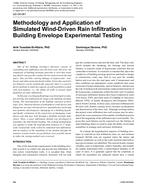Description
One of the building envelope’s functions consists ofcontrolling rain infiltration into the back wall. However, thecomplexity of building envelope junctions is such that watermay find its way past the weather barrier and even into the studspace, thus possibly causing damage to hygroscopic, ironbased,and other materials found within. Given that such failurebehavior can be realistically expected, there is a need todevise methods to study the capacity of wall assemblies to dealwith such failures, i.e., the ability of walls to sustain smallquantities of water infiltration.
To this end, a wetting methodology was developed to simulatedriving rain infiltration for large-scale building envelopetesting. The determination of the loading consisted of threesteps: first, characterization of atmospheric wind-driven raintaking into account relevant factors, quantification of drivingrain quantity and frequency impinging on a building façade,and finally estimation of the proportion of impinging winddrivenrain that may leak through a building envelope deficiency.Then, a water infiltration method was developed toreproduce the determined loading. The wetting methodologywas applied to study the hygrothermal response of 17 largescalewood-frame walls wetted by simulated rain infiltration,and an analysis of the suitability of the method through themoisture content results was performed. Last, possible meansto refine the wetting method were reviewed.
Citation: ASHRAE Trans., vol. 112, pt. 2, paper no. QC-06-061, p. 656-670
Product Details
- Published:
- 2006
- Number of Pages:
- 15
- File Size:
- 1 file , 670 KB
- Product Code(s):
- D-28784




